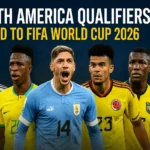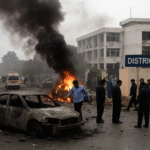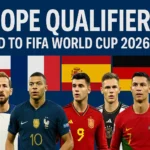The FIFA World Cup 2026 will mark a historic moment for the CONCACAF region as the tournament returns to North American soil for the first time since 1994.
With the United States, Canada, and Mexico sharing hosting duties, all three have automatically qualified, leaving the rest of the region to battle for the remaining spots.
For nations like Costa Rica, Panama, Jamaica, and Honduras, qualification now carries even greater meaning a chance to join football’s biggest event in their own hemisphere.
CONCACAF Qualification Format
The new qualification format highlights both growth and opportunity within the region.
-
The 48-team World Cup structure gives CONCACAF six guaranteed places plus two play-off slots.
-
The three host nations (USA, Canada, Mexico) are automatically qualified.
-
Remaining CONCACAF nations compete for three direct berths and two play-off spots through a multi-round qualification process.
-
Lower-ranked nations began their qualifiers in early 2024, with the decisive final round — now expanded to 12 teams — set to conclude in 2025.
This new system ensures a wider regional representation than ever before.
Current Standings and Key Contenders
As of late 2025, the fight for the remaining North American spots is intensifying.
| FIFA Rank (2025)* | Nation | Status |
|---|---|---|
| #11 | United States | Host / Qualified |
| #12 | Mexico | Host / Qualified |
| #35 | Canada | Host / Qualified |
| #42 | Costa Rica | Strong position, likely qualifier |
| #50 | Panama | In contention for direct qualification |
| #56 | Jamaica | Excellent form, fighting for top 6 finish |
| #68 | Honduras | Mid-table, play-off hopeful |
| #72 | El Salvador | Outside chance, dependent on results |
Approximate FIFA rankings, late 2025.
The key storylines include Panama’s rise, Jamaica’s resurgence under European-based players, and Costa Rica’s continued consistency.
Star Players Defining the Region
United States – Youth with Ambition
-
Christian Pulisic (AC Milan) – creative spark and leader
-
Weston McKennie (Juventus) – box-to-box energy
-
Gio Reyna (Nottingham Forest) – flair and control in attack
Mexico – Tradition Meets Transition
-
Hirving Lozano (PSV) – wide attacking threat
-
Edson Álvarez (West Ham) – midfield anchor and leader
-
Santiago Giménez (Feyenoord) – new goal-scoring sensation
Canada – The Rising Northern Force
-
Alphonso Davies (Bayern Munich) – world-class pace and versatility
-
Jonathan David (Lille) – composed finisher
-
Stephen Eustáquio (Porto) – tactical core of the team
Costa Rica – The Veterans’ Last Dance
-
Keylor Navas (Al Hilal) – inspirational goalkeeper
-
Joel Campbell (León) – dependable and decisive in big games
-
Jewison Bennette (Sunderland) – youthful pace on the flanks
Jamaica – The Reggae Revival
-
Leon Bailey (Aston Villa) – explosive winger
-
Michail Antonio (West Ham) – strength and finishing
-
Demarai Gray (Al-Ettifaq) – adds balance and creativity
Key Trends and Talking Points
-
Home advantage for the Big 3: USA, Mexico, and Canada have already qualified but continue to shape regional football through friendlies and the Nations League.
-
Talent migration: More Caribbean players are breaking into European leagues, improving CONCACAF’s overall technical level.
-
Infrastructure improvement: Stadium upgrades in Costa Rica, Jamaica, and Panama reflect long-term investment.
-
Play-off intensity: Fifth and sixth places could come down to goal difference, with extremely tight margins.
Timeline
-
Final qualification phase: through late 2025
-
Inter-confederation play-off: early 2026
-
World Cup: 11 June – 19 July 2026 (USA, Canada, Mexico)
Conclusion
The North American route to the FIFA World Cup 2026 is more open and competitive than ever.
While the hosts — USA, Mexico, and Canada — focus on preparation, the race for the remaining places highlights the region’s rapid growth.
From Costa Rica’s resilience to Panama’s hunger and Jamaica’s flair, CONCACAF continues to prove that its football can rival any continent.
FAQ – North America World Cup 2026 Qualifiers
Q1. How many CONCACAF teams will play in 2026?
Up to eight — six automatic berths and two via inter-continental play-offs.
Q2. Which nations are already qualified?
United States, Mexico, and Canada as hosts.
Q3. Who are leading the remaining qualifiers?
Costa Rica, Panama, and Jamaica currently occupy the top spots.
Q4. When do the qualifiers finish?
The final round concludes late 2025, with the play-offs held early 2026.
Q5. Who are the key North American players to watch?
Christian Pulisic, Alphonso Davies, Hirving Lozano, Leon Bailey, Jonathan David, and Keylor Navas.
Q6. What makes 2026 unique for CONCACAF?
It’s the first time three nations will co-host a World Cup, with expanded qualification slots for the region.
Q7. How are smaller nations performing?
Honduras, El Salvador, Curaçao, and Trinidad & Tobago remain competitive and could reach the play-offs.










